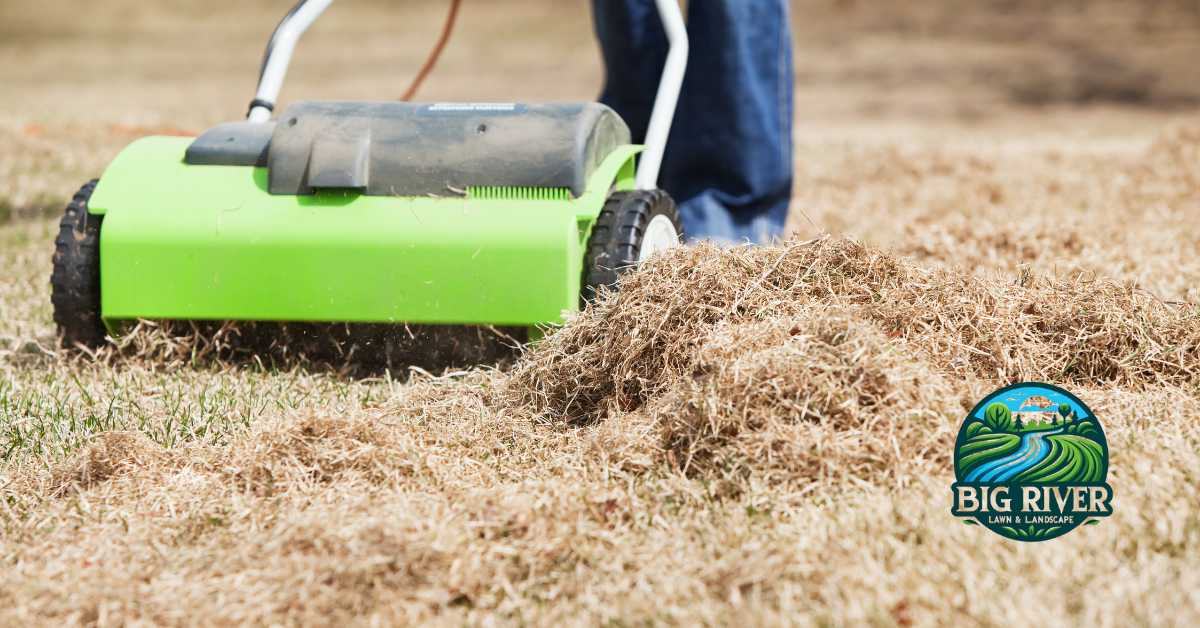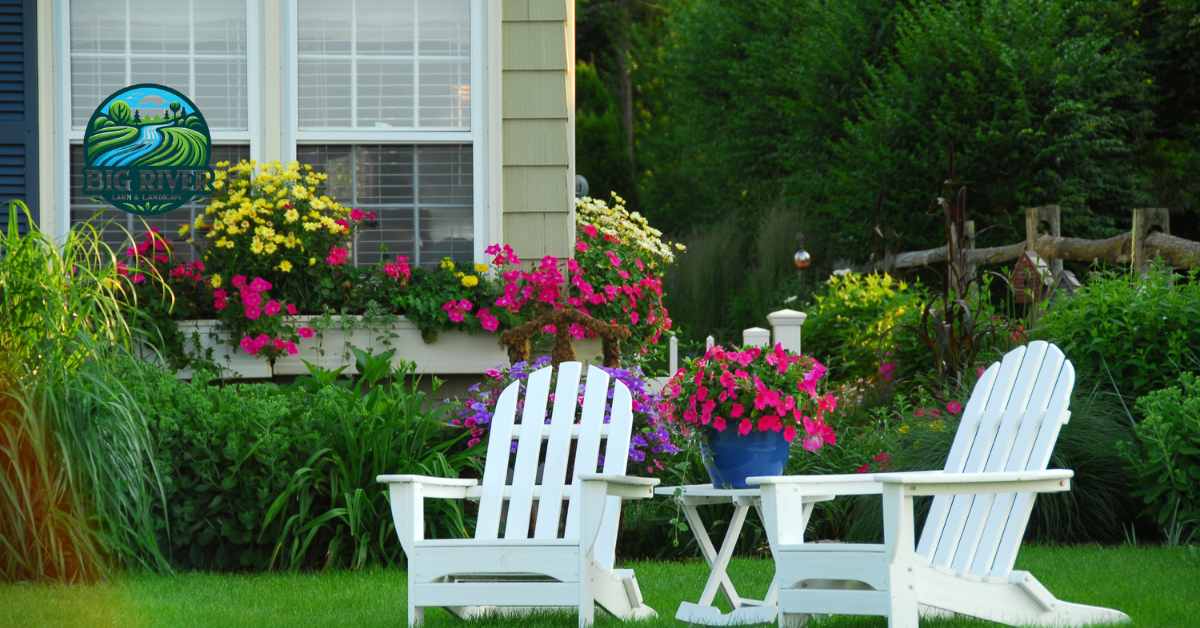Thatch can be a silent enemy to your lawn, lurking unseen until problems become apparent. This guide dives deep into the world of dethatching, explaining what it is, why it’s essential, and how to effectively remove it to ensure your lawn remains healthy and vibrant. By understanding the dynamics of thatch accumulation and the best practices for its removal, you can prevent potential damage that stifles grass growth and compromises the beauty of your green space. Still wondering what is dethatching? This comprehensive resource aims to equip you with the knowledge and techniques to not only tackle existing thatch problems but also to implement preventative measures to maintain a lush, thriving lawn for years to come.
What Is Dethatching?
What is dethatching? Dethatching involves the removal of a layer of dead turfgrass tissue, known as thatch, from between the green vegetation of your lawn and the soil underneath. This process is crucial for maintaining lawn health, as it prevents the thatch from obstructing the essential flow of nutrients, water, and air to the soil. Did you get the answer to the question: what is dethatching a lawn?
Importance of Dethatching for Lawn Health
A healthy lawn can quickly deteriorate if thatch is allowed to build up unchecked. Understanding the importance of de-thatching will help you keep your lawn vibrant and ensure it has access to the necessary resources it needs to thrive.
Understanding Dethatching
Exploring the concept of thatch and its impact on your lawn is crucial. This section will delve into the causes of thatch buildup, its implications, and how regular maintenance can prevent these issues and promote a lush, green lawn.
How Does Thatch Develop?
Thatch is a natural byproduct of a growing lawn, accumulating as dead organic material from grass roots, stems, and leaves gathers faster than it decomposes. Certain maintenance practices and grass types can accelerate this process.
Signs That Your Lawn Needs Dethatching
Recognizing the signs that your lawn needs dethatching can prevent severe damage and maintain its health. A lawn that needs dethatching signs includes a spongy feel underfoot, visible decay beneath the surface, and water runoff despite adequate irrigation.
Benefits of Dethatching
Dethatching your lawn can significantly improve its health and resilience. This section explores the various benefits of dethatching lawns, from enhanced nutrient absorption to improved air circulation within the soil.
Methods of Dethatching
Selecting the right method to remove thatch depends on the severity of the buildup and the size of your lawn. This section covers various techniques, from manual raking to the use of an advanced dethatch machine, offering solutions for every type of lawn care dethatching needed to achieve better benefits of dethatching a lawn.
Manual Dethatching Techniques
Discover traditional and labor-intensive techniques for dethatching your lawn manually and when to dethatch the lawn. These methods are particularly effective for small areas or where delicate care is needed. Dethatching yards also add more benefits.
Hand Dethatching
This method involves direct, manual removal of thatch using simple tools, ideal for tackling small patches of lawn that are beginning to show signs of distress.
Dethatching Rake
Unlike traditional rakes, dethatching rakes feature sharp, serrated blades or tines that penetrate the thatch layer, loosening it from the soil below. These rakes are available in various designs, including handheld models with adjustable handles and wide heads for efficient coverage.
Mechanical Dethatching Methods
For larger or more heavily thatched lawns, mechanical methods provide an efficient solution. This section covers the various tools and machines designed for extensive dethatching and experience various benefits of dethatching your lawn.
Power Raking
Power raking involves mechanical tools that make quick work of thick thatch layers suitable for extensive lawns suffering from severe thatch problems.
Dethatching Machines
Vertical mowers, or dethatching machines, offer a powerful way to clear thatch across large areas, ensuring your lawn breathes and absorbs nutrients effectively.
Chemical Dethatching Options
Chemical dethatching can be a viable alternative or complement to physical methods, especially in delicate situations or as preventative maintenance.
The Role of Chemical Agents
Chemical agents play a crucial role in the process of dethatching by breaking down the organic matter that forms thatch on the surface of the lawn. These agents typically contain enzymes or acids that help accelerate the decomposition of dead grass, moss, and other debris, making it easier to remove them from the soil.
Safety Considerations
Using chemicals requires careful handling and adherence to safety guidelines to protect both your lawn and the environment.
Dethatching: Timing and Frequency
When to dethatch lawn? Proper timing and determining the correct frequency are critical for effective dethatching without harming your lawn. This section provides insights into when and how often you should undertake this task, helping you maintain a healthy lawn throughout the year.
Best Time to Dethatch Your Lawn
The best time to dethatch your lawn depends largely on the type of grass you have. Cool-season grasses are best dethatched in early spring or early fall, while warm-season grasses should be dethatched in late spring, just as they enter their peak growing season. So, it is better to know when to dethatch lawns.
Factors Influencing Dethatching Frequency
Several factors affect how often dethatching is needed, including grass type, soil quality, climate, and lawn care practices. Generally, lawns should be dethatched every 1-3 years, but lawns under intense use or those in poor health might need more frequent dethatching.
Signs of Over-Dethatching
While dethatching can be beneficial, too much can damage your lawn. Signs of over-dethatching include bare spots, increased susceptibility to weeds and diseases, and general lawn stress. Monitoring your lawn’s response after each dethatching will help you adjust your practices accordingly.
Preparing for Dethatching
Before you begin dethatching, it’s important to assess your lawn’s condition and prepare adequately to ensure the best results without damaging your grass.
Assessing Your Lawn’s Condition
Examine your lawn to determine the thickness of the thatch layer and the overall health of the grass. This will help you decide the intensity of dethatching needed and the best method to use.
Necessary Tools and Equipment
Depending on the size of your lawn and the severity of thatch, you might need a simple rake or more robust equipment like a power rake or vertical mower. Ensure you have all the necessary tools at hand before starting.
Pre-Dethatching Preparations
Check out the pre-dethatching preparations for healthy dethatching:
Mowing the Lawn
Mow your lawn to about half its normal height before dethatching. This will make the process easier and more effective, allowing better access to the thatch layer.
Irrigation Considerations
Water your lawn one to two days before dethatching to soften the soil and make the process less stressful for the grass.
Dethatching Process
Executing the dethatching process properly is essential for maximizing the health benefits while minimizing stress on your lawn.
Step-By-Step Guide to Manual Dethatching
Maintaining a lush, vibrant lawn requires more than just regular mowing and watering. Over time, layers of dead grass, moss, and debris can accumulate, inhibiting the healthy growth of your turf. Check out the step-by-step guide to have a healthy dethatching:
- Assess Your Lawn: Examine your lawn to determine if it needs dethatching. Look for thick layers of dead grass, moss, and debris that can hinder healthy growth.
- Choose the Right Time: Opt for a time when the lawn is dry, but the soil is still moist, typically in early spring or fall. Avoid dethatching during extreme heat or drought conditions.
- Gather the Necessary Tools: You’ll need a dethatching rake or a manual dethatching tool, a lawn mower with a dethatching blade attachment (optional), a leaf rake, and a lawn waste bag or bin.
- Mow the Lawn: If you’re using a dethatching blade attachment, mow your lawn to a shorter height than usual. This will make it easier to dethatch and remove debris.
- Dethatch in Sections: Divide your lawn into manageable sections to work on. Start at one edge and work your way across, using the dethatching rake or tool to remove the thatch layer.
- Use Proper Technique: Hold the dethatching tool at a slight angle and move it in short, quick strokes across the lawn. Be thorough but gentle to avoid damaging the grass roots.
- Collect Debris: As you dethatch, use a leaf rake to gather up the loosened debris and dead grass. Dispose of it in a lawn waste bag or bin.
- Water and Fertilize: After dethatching, water your lawn to help it recover from the process. Consider applying a balanced fertilizer to promote healthy regrowth.
- Monitor and Repeat: Keep an eye on your lawn in the following weeks to ensure it’s recovering well. Depending on the severity of thatch buildup, you may need to repeat the dethatching process every few years.
Using Mechanical Dethatching Equipment
For larger areas or heavily thatched lawns, mechanical grass dethatchers like power rakes or vertical mowers are more efficient. Operate the machine in a pattern that covers the lawn thoroughly without overlapping excessively.
Applying Chemical Agents for Dethatching
Chemical dethatchers should be used according to manufacturer instructions and only when necessary, as they can affect soil chemistry and microbial health.
Aftercare and Maintenance
After de-thatching, proper care is crucial to help your lawn recover and thrive. This stage is essential for revitalizing the grass and ensuring that your lawn returns to its optimal condition swiftly. Adequate aftercare facilitates rapid recovery, minimizes stress, and promotes healthier, more robust grass growth in the following weeks.
Cleaning Up After Dethatching
Collect and dispose of the thatch debris. Leaving it on your lawn can smother grass and lead to further issues. It’s important to ensure that all debris is removed efficiently, as any remnants can hinder the recovery process and potentially reintroduce pathogens or pests back into the lawn. A thorough cleanup helps prevent these problems and prepares the ground for effective post-dethatching treatments.
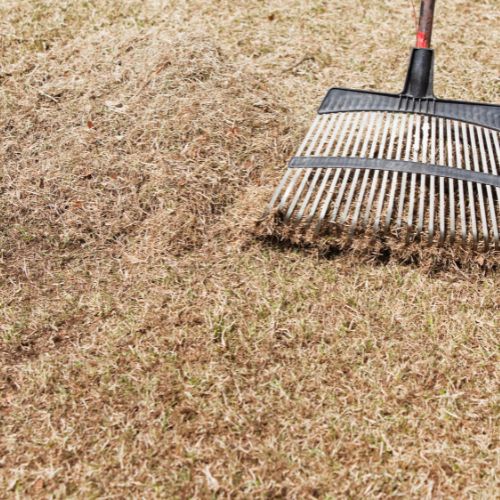
Post-Dethatching Lawn Care Practices
There are various post-dethatching lawn care practices for a healthy lawn. Check out the headings below for more in-depth information:
Fertilizing
Apply a balanced fertilizer after dethatching to replenish nutrients and encourage healthy regrowth. This step is critical as it provides essential nutrients that can be absorbed more effectively by the lawn’s exposed roots. Ensuring that the fertilizer matches the specific needs of your soil and grass type can dramatically improve the recovery rate and overall health of your lawn.
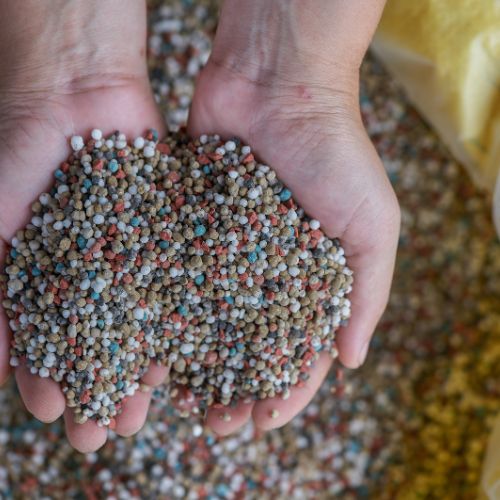
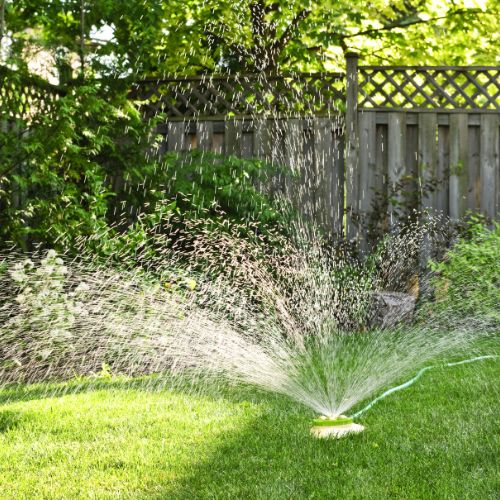
Watering
Water the lawn deeply but infrequently to promote strong root growth. This method helps establish deeper root systems, which enhance the lawn’s resilience to drought and other stressors. A properly maintained sprinkler system helps watering after dethatching and is vital for facilitating the germination of new seeds, especially if overseeding is also performed.
Overseeding (If Necessary)
If dethatching has created bare spots or thinned areas, overseeding might be necessary to ensure an even, lush lawn. This process not only fills in unsightly gaps but also introduces new, vigorous growth, which can improve the overall density and appearance of your lawn. Overseeding after dethatching can be particularly effective because the seeds have better contact with the soil, enhancing their chances of successful germination and growth.
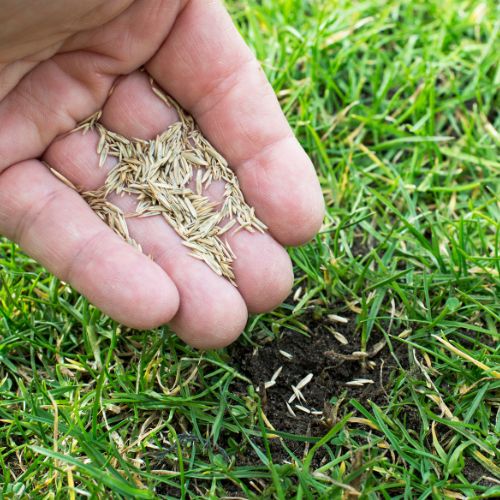
Troubleshooting and Common Mistakes
Even with careful planning, dethatching can sometimes lead to unexpected challenges or suboptimal results. So, how to de-thatch a lawn? This section discusses how to identify and address common issues, avoid typical mistakes, and correct uneven results to ensure that your dethatching efforts are effective and beneficial for your lawn.
Addressing Common Issues During Dethatching
It’s not uncommon to encounter problems such as excessive turf damage or incomplete thatch removal during the dethatching process. Recognizing these issues early and understanding how to adjust your technique or equipment settings can help mitigate damage and improve outcomes.
Avoiding Pitfalls and Mistakes
Many dethatching errors stem from incorrect timing, using inappropriate equipment, or failing to adjust for the specific type of grass or soil condition. This subsection provides guidance on how to sidestep these common pitfalls to maintain the integrity and health of your lawn.
Solutions for Uneven Dethatching Results
How to dethatch a lawn? Uneven dethatching can leave your lawn looking patchy and vulnerable to weeds and diseases. Here, we’ll explore techniques to achieve more uniform results, such as overlapping passes with the grass dethatcher or adjusting the depth settings on your equipment.
Advanced Dethatching Techniques
Advanced dethatching techniques can enhance results for those looking to optimize their lawn care regimen. This section covers combining dethatching with other lawn maintenance practices, the benefits of additional treatments, and when it might be best to call in professional Lawn Care Services.
Aerating in Conjunction with Dethatching
Aerating your lawn at the same time as dethatching can greatly improve soil structure and grass health. This approach allows for deeper penetration of water and nutrients and helps relieve soil compaction, promoting a healthier, more resilient lawn.
Topdressing for Enhanced Lawn Health
Following up dethatching with topdressing — applying a thin layer of organic material over your lawn — can help restore soil balance and promote healthy grass growth. This method enhances soil fertility and improves moisture retention, which is especially beneficial after the stress of dethatching.
Professional Dethatching Services
For large or severely compacted lawns or simply to ensure the best results, hiring professional dethatching services might be advisable. Professionals have access to high-grade equipment and extensive experience in different lawn types and conditions, ensuring efficient and effective dethatching.
Environmental Considerations
Dethatching, like all lawn maintenance activities, has environmental impacts. This section emphasizes practices that minimize harm to the ecosystem, promote sustainability, and handle waste responsibly.
Eco-Friendly Dethatching Practices
Adopting eco-friendly dethatching practices such as using electric or manual dethatching tools can reduce pollution and energy use. Additionally, timing your dethatching to coincide with seasonal growth cycles can decrease the lawn’s recovery time and reduce the need for chemical treatments.
Disposal of Dethatching Debris
Proper disposal of dethatching debris is crucial to avoid environmental pollution and potential pest problems. This subsection discusses environmentally responsible ways to dispose of organic waste, including composting and local green waste programs.
Organic Alternatives to Chemical Dethatching Agents
For those seeking a more natural approach, this section provides information on organic alternatives to chemical dethatching agents. These alternatives, such as compost teas or microbial additives, offer a way to help decompose thatch without the use of harsh chemicals.
Wrapping Up
Dethatching is a critical aspect of lawn maintenance that, when done correctly, can significantly enhance the health and appearance of your lawn. This guide has covered everything from the basics of dethatching to more advanced techniques and environmental considerations, providing you with the knowledge to achieve and maintain a beautiful, healthy lawn.
FAQs On Dethatching
What Time of Year Is Best to Dethatch a Lawn?
The best time to dethatch your lawn depends on the type of grass. For cool-season grasses, such as fescue, bluegrass, and ryegrass, early spring or early fall are ideal, as these times align with the grass’s natural growth spurts. For warm-season grasses like Bermuda, zoysia, and St. Augustine, late spring through early summer is the optimal time, just as the grass enters its peak growing period. This timing helps the lawn recover quickly and take full advantage of its growth cycle.
What Is the Purpose of Dethatching Your Lawn?
Dethatching helps to remove the buildup of thatch, a layer of dead and living grass shoots stems, and roots that occur between the soil surface and the live green vegetation. If thatch accumulates too thickly, it can prevent water, nutrients, and air from reaching the soil and grass roots, leading to a less healthy lawn. Dethatching helps maintain the lawn’s health by ensuring these essential elements can penetrate the soil effectively.
Is It Better to Aerate or Dethatch Your Lawn?
Whether to aerate or dethatch your lawn depends on the specific condition. Lawn Aeration is typically used to alleviate soil compaction and improve water and nutrient flow to roots, which is particularly beneficial for lawns with heavy clay soils or those subjected to high foot traffic. Dethatching, on the other hand, is necessary when there is a visible layer of thatch that is more than half an inch thick. Many lawns benefit from both processes, but they should not typically be done at the same time to avoid stressing the grass.
What Happens If You Never Dethatch Your Lawn?
Failing to dethatch a lawn that needs it can lead to several problems. A thick thatch layer can create a barrier that prevents moisture, nutrients, and air from reaching the soil and grass roots. Over time, this can cause the lawn to become less drought-resistant, more susceptible to disease, and overall less vigorous and healthy. Additionally, a thick thatch layer can provide a habitat for pests.
What Is the Best Way to Pick Up After Dethatching?
The most efficient way to pick up after dethatching is to use a lawn mower with a bagging attachment to collect the loosened thatch, or you can rake it up manually with a leaf rake. For larger lawns, a lawn vacuum or sweeper can speed up the process. It’s important to remove the collected thatch from your lawn to prevent it from settling back into the grass and compacting, which would counteract the benefits of dethatching.
What Is a Dethatcher and Scarifier?
What does a dethatcher do? A dethatcher, also known as a scarifier, is a tool designed to remove thatch from a lawn. Thatch is a layer of organic matter that includes dead grass, roots, and debris that accumulates between the soil surface and the live grass blades. When this layer becomes too thick, it can prevent water, nutrients, and air from reaching the soil and grass roots, which can impede the health and growth of the lawn.

